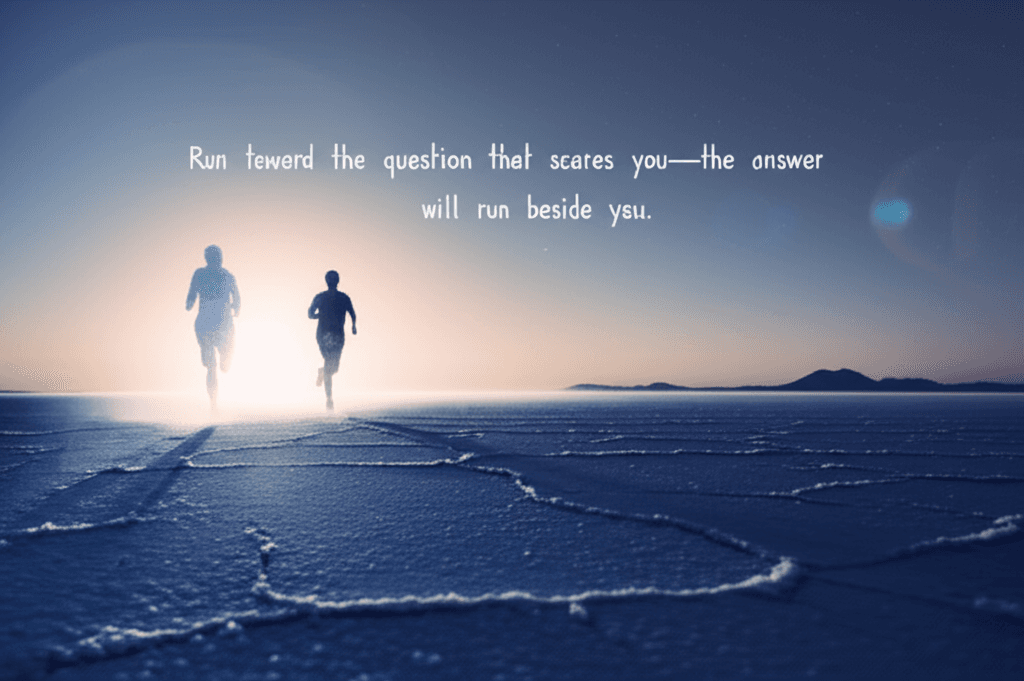Chasing Fear Until Insight Runs Beside You
Created at: August 23, 2025

Run toward the question that scares you—the answer will run beside you. — Haruki Murakami
Turning Toward the Fearful Question
Murakami’s line suggests a counterintuitive posture: instead of fleeing uncertainty, we move toward it. The metaphor of running reframes inquiry as kinetic, not static—answers are companions revealed by motion, not trophies seized at the finish line. Thus, the scary question is less a wall than a starting gun. Seen this way, courage becomes a pacing strategy. We do not annihilate fear; we outlast it, allowing clarity to keep stride as we acclimate to discomfort. By keeping company with the question, we discover that insight is not hiding ahead—it is matching our gait.
Murakami’s Running as Inquiry
In What I Talk About When I Talk About Running (2007), Murakami entwines endurance with attention, implying that steady forward motion metabolizes confusion. His oft-cited maxim—“Pain is inevitable. Suffering is optional.”—captures how discipline converts raw difficulty into meaning through rhythm and repetition. Moreover, his account of the 100 km Lake Saroma ultramarathon (1996) shows answers appearing mile by mile, not in epiphanic bursts. In this light, running beside the answer is literal and figurative: body and mind synchronize, and questions resolve as stamina turns chaos into cadence.
Philosophical Companions to Courage
This ethos echoes older traditions. Rainer Maria Rilke urged us to “live the questions” (Letters to a Young Poet, 1903), trusting that patience ripens understanding. Similarly, Plato’s Theaetetus (c. 369 BC) portrays Socrates as a “midwife” of ideas, staying with aporia—the perplexing gap—until knowledge is born. Likewise, the hero’s journey frames dread as a doorway: Joseph Campbell’s The Hero with a Thousand Faces (1949) associates the feared cave with hidden treasure. Together these voices affirm Murakami’s suggestion: approach begets revelation.
Psychology of Approach Over Avoidance
Contemporary research clarifies why running toward fear works. Exposure therapy updates threat predictions through inhibitory learning, so anxiety diminishes as the brain revises its model of danger (Craske et al., 2014). Acceptance and Commitment Therapy teaches moving toward valued aims while carrying discomfort, rather than waiting to feel fearless first (Hayes, Strosahl, and Wilson, 1999). Furthermore, Loewenstein’s “information-gap” theory shows curiosity intensifying when we sense a precise hole in knowledge (1994); approaching the gap sustains motivation, while avoidance keeps it aching. Put simply, approach turns dread into data.
Creativity as a Long Run
Creative work mirrors endurance running: progress accumulates through repeated, purposeful strides. Murakami describes writing as a daily training plan—quiet hours, consistent mileage of words, and recovery that protects the next session (What I Talk About…, 2007). The lesson is iterative: clarity arrives in motion. Philosophers noticed the same kinship between walking and thought; Nietzsche quipped, “All truly great thoughts are conceived while walking” (Twilight of the Idols, 1888). Movement, then, is not a distraction from inquiry but its engine.
Practices to Let Answers Keep Pace
Finally, we can operationalize the metaphor. Begin by phrasing the problem as a single, vivid question, then set a modest “run” of time—say, twenty-five minutes—dedicated to exploring it without judgment. Next, pair thinking with movement: a brisk walk or easy jog while dictating notes keeps attention elastic. Afterward, cool down by writing the clearest sentence learned, even if provisional. Sustained by small, repeatable rituals, you will notice the answer no longer waits at the finish. As Murakami implies, it matches your stride the moment you commit to the run.